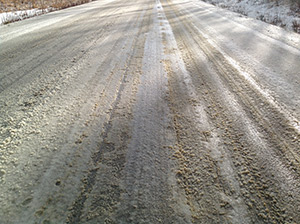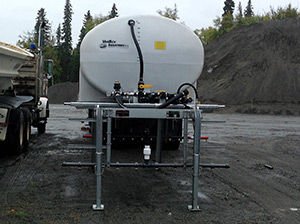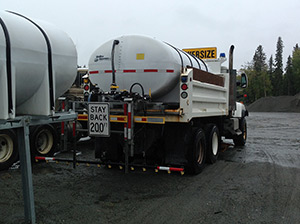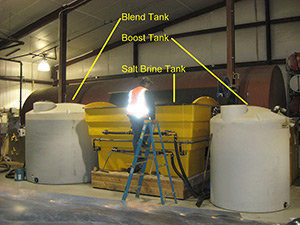Salt Brine
Alaska DOT&PF uses several tools to combat snow and ice conditions on Alaska Transportation network. A newer tool for us that can be used in certain conditions is salt brine.
Salt brine (a freeze-point depressant) is a relative newcomer in the department's arsenal against ice and snow, which also includes an advanced equipment fleet, salt and sand. The region adopted the use of salt brine about five years ago, as a result of the rising cost of magnesium chloride, which had been used before.
What it is
The salt brine solution is made up of water mixed with 23.3 percent sodium chloride. Because corrosion from salt presents a problem for roadways, the department adds an organic compound to the mixture that makes the solution one-third as corrosive as salt. The additive also lowers the effective temperature of the salt brine solution.
What it does
The salt brine mixture features in the department's anti-icing measures. Anti-icing involves treating bare roads before a winter storm event with the solution to slow or prevent the build-up of snow and ice. Salt brine applied before a storm forms a bond breaker between the pavement surface and the snow and ice layer reducing the chances that ice will form and bond to the pavement surface. Northern Region used to focus solely on de-icing but has since incorporated a more proactive anti-icing strategy.
When it's used
Timing plays an important role in the effectiveness of anti-icing measures. The salt brine solution works best when applied before snow and ice accumulate on roadways and at temperatures of 20 F and above. Another key factor in deciding on whether the anti- icing solution will be applied is pavement temperature. To be effective in combating ice, salt brine should be applied on pavement temperatures of +15 F or higher.
Once snow and ice have accumulated, crews switch to de-icing measures. Salt brine can still be used, but instead of being applied directly, the mixture is sprayed onto sand as it is applied by sand trucks to roadways. This process makes the sand penetrate the ice better as well as aiding in the reduction of sand scatter from the traveled roadway. Pre wetting our sand before application has shown to reduce the loss of sand off the roadways, thus reducing the amount of sand applied.
DOT&PF is focused on maintaining safe roads for the public, brine was implemented because:
Safety is Number One - the data strongly supports that brine is particularly effective at preventing ice and snow build up given the direct application and rate of active melting which results in removing ice and snow that has already adhered to asphalt.
Micro-Climate Strategies - challenging winter conditions and freeze/thaw cycles require different strategies to keep roads safe in different areas of Alaska.
Environmental Sensitivity - rock salt is known to be among the most corrosive materials used in snow and ice control. Additives can be added to minimize corrosion while still maintaining the effectiveness of the product.
Drift, Scatter and Bounce - winds can blow off rock salt and sand, making it a more expensive treatment both in terms of purchasing, but also in labor costs when maintenance workers have to reapply frequently. Aside from wind, scattering solid sand and salt doesn't always "burn in" to the surface and more is lost from bouncing during application or car tires kicking it off the road.
Costs and Alternatives - salt brine is a less expensive product for clearing ice and snow from roadways, compared to other products, which allows finite state funding to be utilized on other priorities such as equipment, staffing, and other safety maintenance improvement.
How is DOT&PF balancing the benefits and the concerns about salt brine?
-
The department is committed to being judicial with its application of brine. Our focus is on applying brine in areas that pose the most risk to motorists if not treated for snow and ice control, such as high speed facilities, curves, hills and intersections.
-
Conducting a literature search to see what studies have been completed on the effects of salt brine. We will share the results of that search with the public and policy makers.
-
We're working on an update to the M&O manual to include a brine section to ensure brine is being applied in appropriate conditions, and in the most effective way possible to ensure the maximum benefit to the public.




